Liberty Head Quarter
1892 to 1916
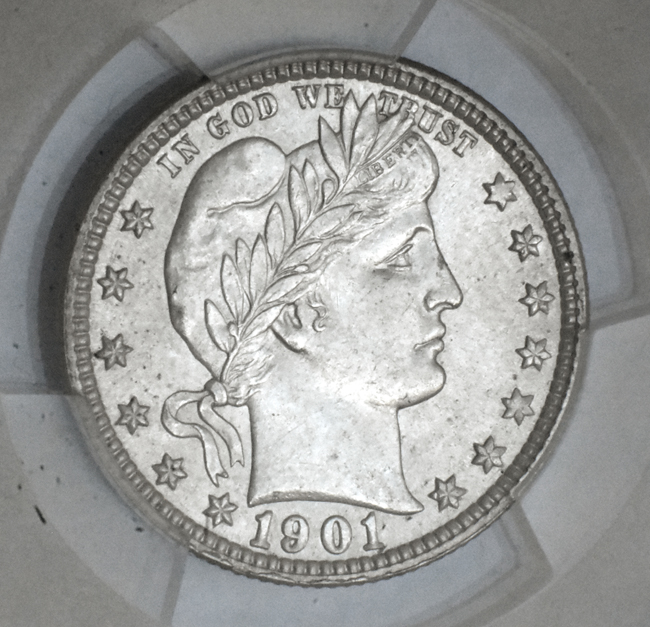 |
In 1892 the quarter was designed again by Charles Barber. On the reverse, the shield eagle is holding arrows and a branch with the words QUARTER DOLLAR now spelled out in full. This coin, made for 24 years, was made at four different mints, including Denver and San Francisco, and is very popular with collectors. The composition is the same as the previous one, being 90% silver and 10% copper and the size is 24.3mm. A number of issues of this coin in choice condition (MS65) are rare and very valuable. And three issues are rare even in Good grade, the 1901 S being the most valuable, worth over $5,000 for a G4. | 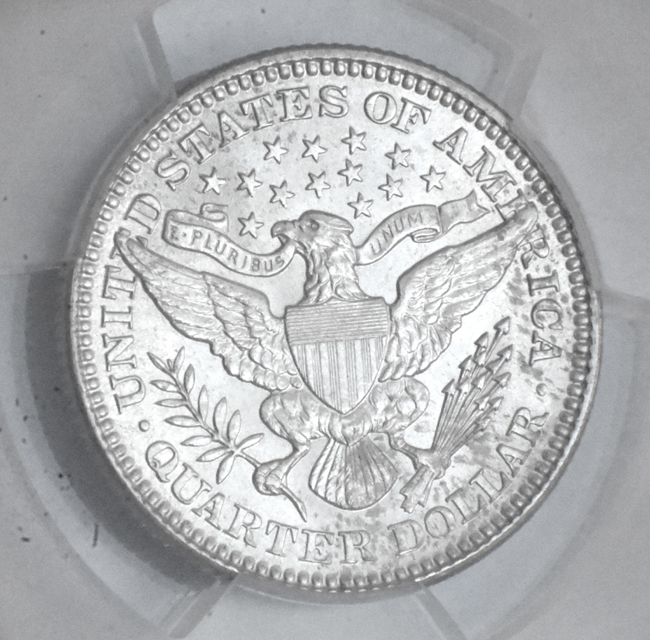 |
| This coin is slabbed and certified by PCGS as MS 63 and it cost me a bundle. But at least I have a decent photo to post here and the Red Book says it is worth $425. It is stored in the red box. I do have an album of these coins, with 70 issues out of the 73 that were put in circulation. Unfortunately, I likely will never acquire an example of the 1901 S. | This is the reverse of the coin at left. I was obviously disappointed to see the stain on this reverse side. I may have overpaid for this one. And it is not the 'S' example which would have made it worth a fortune. Almost 9 million of these quarters were minted. | |
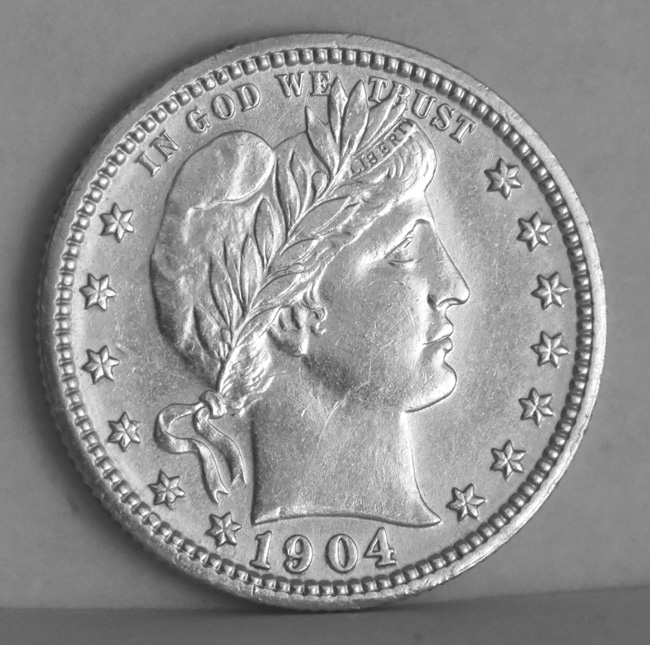 |
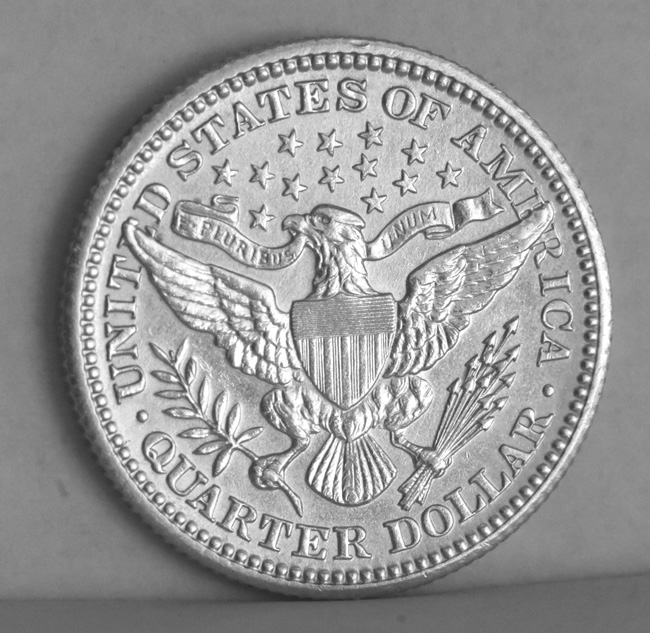 |
|
| The 1904 coin above is an AU 53 example, certified and slabbed by ANACS. I bought it for the D case, removed it from the slab, and it currently resides there. | This is the reverse of the coin at left. 9,588,143 of these were minted in Philadelphia. | |
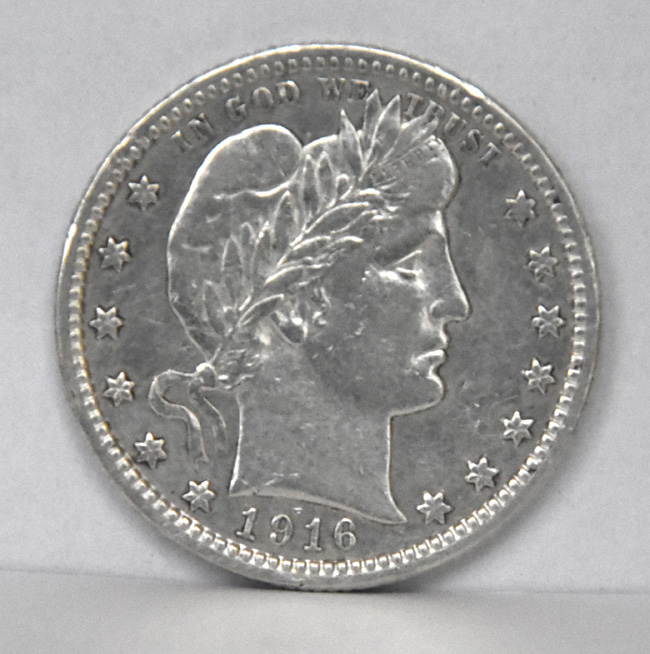 |
|
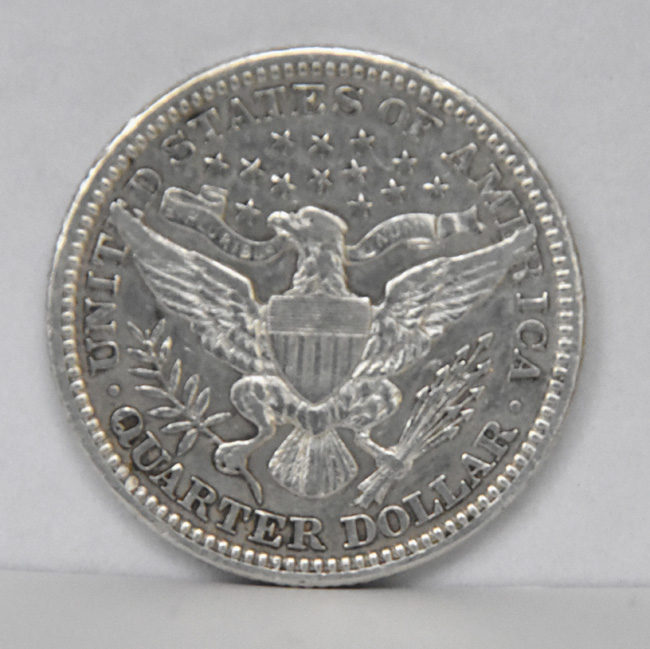 |
| My Philadelphia example above is worth at least $100. The grade of AU would indicate a value of $140 but the coin appears to have been cleaned, which would lower that figure. | This is the reverse of the coin at left. Only 1,788,000 of these coins were minted. |
January 5, 1901 – Typhoid Fever breaks out in a Seattle jail, the first of two typhoid outbreaks in the United States during the year. January 10 – In the first great Texas gusher, oil is discovered at Spindletop in Beaumont, Texas. March 4 – William McKinley is sworn in, for a second term as President of the United States. March 17: A showing of 71Vincent van Gogh paintings in Paris, 10 years after his death, creates a sensation. April 25: New York becomes the first U.S. state to require automobile license plates. May 3: The Great Fire of 1901 begins in Jacksonville, Florida. May 17: The Panic of 1901 begins when the New York Stock Exchange crashes. August 14: The first claimed powered flight is made, by German-born American aviator Gustave Whitehead, in his Number 21, in Connecticut. September 2: U.S. Vice President Theodore Roosevelt utters the famous phrase, "Speak softly and carry a big stick", at the Minnesota State Fair. October 24: Michigan schoolteacher Annie Edson Taylor goes over Niagara Falls in a barrel, and survives. September 6: William McKinley assassination: American anarchist Leon Czolgosz shoots U.S. President William McKinley at the Pan-American Exposition in Buffalo, New York. McKinley dies 8 days later. December 12: Guglielmo Marconi receives the first trans-Atlantic radio signal, sent from Poldhu, England, to Newfoundland; it is the letter "S" in Morse code. (date unknown): American businessman William S. Harley draws up plans for his first prototype motorcycle. |
January 24 , 2016: In Browning, Montana, the temperature drops from 44 °F to −56 °F in one day, the greatest change ever on record for a 24-hour period. February 11: Emma Goldman is arrested for lecturing on birth control. March 8 and 9: Mexican Revolution: Pancho Villa leads about 500 Mexican raiders in an attack against Columbus, New Mexico, killing 12 U.S. soldiers. A garrison of the U.S. 13th Cavalry Regiment fights back and drives them away. March 15: President Woodrow Wilson sends 12,000 United States troops over the U.S.-Mexico border to pursue Pancho Villa; the 13th Cavalry regiment enters Mexican territory. June 15: U.S. President Woodrow Wilson signs a bill incorporating the Boy Scouts of America. July 1 to 12: At least one shark mauls five swimmers along 80 miles of the New Jersey coastline resulting in four deaths and the survival of one youth who required limb amputation. This event is the inspiration for author Peter Benchley, over half a century later, to write Jaws. August 25: U.S. President Woodrow Wilson signs legislation creating the National Park Service. September 1: The Keating-Owen Act, the first federal law to restrict child labor, is passed, but is ruled unconstitutional in 1918. October 16: Margaret Sanger opens a family planning and birth control clinic in Brownsville, Brooklyn, the first of its kind in the U.S., a forerunner of Planned Parenthood.] Nine days later, she is arrested for breaking a New York state law prohibiting distribution of contraceptives. November 1: The first 40-hour work week officially begins in the Endicott-Johnson factories of Western New York. November 21: The U.S. rejects a German offer of £10000 per American lost in the sinking of the RMS Lusitania. The following April, President Wilson asks the U.S. Congress for a declaration of war on Germany. |
